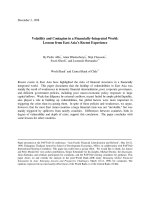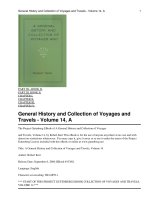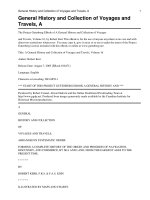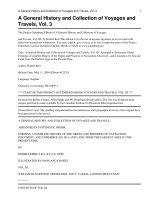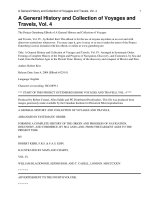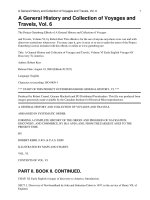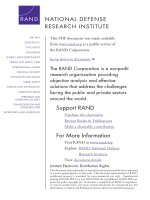Asia a concise history
Bạn đang xem bản rút gọn của tài liệu. Xem và tải ngay bản đầy đủ của tài liệu tại đây (8.1 MB, 498 trang )
Tai Lieu Chat Luong
ffirs.indd ii
4/5/11 9:34:41 AM
Asia
A Concise History
ffirs.indd i
4/5/11 9:34:41 AM
ffirs.indd ii
4/5/11 9:34:41 AM
Asia
A Concise History
Arthur Cotterell
John Wiley & Sons (Asia) Pte. Ltd.
ffirs.indd iii
4/5/11 9:34:41 AM
Copyright © 2011 John Wiley & Sons (Asia) Pte. Ltd.
Published in 2011 by John Wiley & Sons (Asia) Pte. Ltd.
1 Fusionopolis Walk, #07-01, Solaris South Tower, Singapore 138628.
All rights reserved.
No part of this publication may be reproduced, stored in a retrieval system, or
transmitted in any form or by any means, electronic, mechanical, photocopying,
recording, scanning, or otherwise, except as expressly permitted by law, without
either the prior written permission of the Publisher, or authorization through
payment of the appropriate photocopy fee to the Copyright Clearance Center.
Requests for permission should be addressed to the Publisher, John Wiley & Sons
(Asia) Pte. Ltd., 1 Fusionopolis Walk, #07-01, Solaris South Tower, Singapore
138628, tel: 65-6643-8000, fax: 65-6643-8008, e-mail:
This publication is designed to provide accurate and authoritative information in
regard to the subject matter covered. It is sold with the understanding that the
publisher is not engaged in rendering professional services. If professional advice
or other expert assistance is required, the services of a competent professional
person should be sought.
Neither the authors nor the publisher are liable for any actions prompted or
caused by the information presented in this book. Any views expressed herein
are those of the authors and do not represent the views of the organizations they
work for.
Other Wiley Editorial Offices
John Wiley & Sons, 111 River Street, Hoboken, NJ 07030, USA
John Wiley & Sons, The Atrium, Southern Gate, Chichester, West Sussex, P019
8SQ, United Kingdom
John Wiley & Sons (Canada) Ltd., 5353 Dundas Street West, Suite 400, Toronto,
Ontario, M9B 6HB, Canada
John Wiley & Sons Australia Ltd., 42 McDougall Street, Milton, Queensland 4064,
Australia
Wiley-VCH, Boschstrasse 12, D-69469 Weinheim, Germany
Library of Congress Cataloging-in-Publication Data
ISBN
ISBN
ISBN
ISBN
978-0470-82504-4
978-0470-82958-5
978-0470-82957-8
978-0470-82959-2
(Hardcover)
(ePDF)
(e-Mobi)
(ePub)
Typeset in 10.5/13.5pt ITC Galliard by MPS Limited, a Macmillan Company
Printed in Singapore by Saik Wah Print Media Pte. Ltd.
ffirs.indd iv
4/5/11 9:34:42 AM
For the
Class of 1968, V Arts,
St. Thomas’ School, Kuching,
Sarawak
ffirs.indd v
4/5/11 9:34:42 AM
ffirs.indd vi
4/5/11 9:34:42 AM
Contents
Preface
Introduction
List of Maps
Photo Credits
xi
xiii
xx
xxi
PART 1: ANCIENT ASIA
1
Chapter 1: Ancient West Asia
3
The First Civilisation: Sumer
3
The Great Empires: Babylon, Assyria and Persia
12
Understanding the World: Religion and Myth
21
Endgame: Greco-Roman Europe
Versus Persian Asia
30
Chapter 2: Ancient South Asia
41
Asia’s Second Civilisation: The Indus Valley
41
Epic India: The Aryan Invasion
49
The Buddhist Revolution: The Mauryan Empire
55
The Age of Invasion: From the Bactrians
to the Huns
64
Chapter 3: Ancient East Asia
74
The Cradle of the East: The Shang Dynasty
74
Classical China: The Zhou Dynasty
82
Imperial Unification: The Qin and
Former Han Emperors
90
Imperial Crisis: The Failure of the Later Han
Chapter 4: Ancient Central Asia
100
107
The Steppe: An Intercontinental Highway
107
Nomads: The Scourge of the Sown
116
The Spread of Buddhism: The First Pan-Asian Faith
126
The Great Raid: Attila the Hun
135
vii
toc.indd vii
3/29/11 10:21:07 AM
Contents
PART 2: MEDIEVAL ASIA
141
Chapter 5: Medieval West Asia
143
Islam: The Second Pan-Asian Faith
143
The Umayyad and Abbasid Caliphates
151
The Coming of the Seljuks
157
The Crusades
161
Safavid Persia
166
The Ottoman Empire
171
Chapter 6: Medieval South Asia
178
The Arrival of Islam
178
The Hindu and Buddhist Kingdoms
186
The Mughal Empire
192
European Rivalry
202
The British Triumph
210
Chapter 7: Medieval East Asia
213
Tang and Song China
213
Confucian Korea
225
Feudal Japan
230
The Ming Revival
239
Chapter 8: Medieval Central Asia
246
The Turks and the Qidans
246
The Tibetan Empire
251
The Mongol Empire
256
Tamerlane, the Sword of Islam
267
The Manchu Conquests
271
Chapter 9: Medieval Southeast Asia
277
Independent Vietnam
277
The Khmer Empire
282
viii
toc.indd viii
3/29/11 10:21:07 AM
Contents
The Kingdoms of Burma
289
The Island Powers: Srivijaya, Mataram
and Majapahit
293
The Slow Spread of Islam
300
The Advent of European Power
302
The Rise of the Thai
307
PART 3: MODERN ASIA
315
Chapter 10: Modern West Asia
317
The Fall of the Ottoman Empire
317
Between World Wars
322
The Founding of Israel
327
Syria, Lebanon and Jordan
328
Iraq versus Iran
330
Saudi Arabia and the Gulf States
335
Modern Turkey
336
Chapter 11: Modern South Asia
339
The British Raj
339
The Indian Mutiny
344
The End of Company Rule
351
Gandhi and Indian Nationalism
353
Independence and Partition
358
Sri Lanka and Bangladesh
360
Chapter 12: Modern East Asia
363
China’s Humiliation
363
Japanese Imperialism
369
The People’s Republic of China
378
The Korean War
382
The Rise of the Pacific Rim
384
ix
toc.indd ix
3/29/11 10:21:07 AM
Contents
Chapter 13: Modern Central Asia
386
The Russian Advance
386
The Great Game
393
Afghanistan, the Land of Bones
397
Siberia and Mongolia
400
The Central Asian Republics
403
Chapter 14: Modern Southeast Asia
407
The Dutch East Indies
407
The British Possessions
410
French Indochina and Thailand
415
The Greater East Asia Co-Prosperity Sphere
419
Post-War Decolonisation
423
The Republic of Indonesia
427
The Tragedy of Vietnam
430
Filipino Democracy
434
Postscript: The Rise of Present-Day Asia
Glossary
Further Reading
Index
437
441
444
453
x
toc.indd x
3/29/11 10:21:08 AM
Preface
“
I
mpossible. I’ve spent my entire life thinking about classical Greece.”
Thus George Forrest responded to a request for a 5,000-word
article when telephoned one Friday evening in Oxford. Without
hesitation, I told him to imagine that he was going to be shot by the
junta next Tuesday and this was his last chance to leave behind a considered view. “I’ll do it,” he said to my relief as editor of the Penguin
Encyclopedia of Ancient Civilizations. And I consider his contribution
still unmatched as an introduction to the subject.
A not dissimilar feeling of impossibility assailed me when my
publisher, Nick Wallwork, thought that a history of Asia was a good
idea. Even though I have been allowed many more words, the subject
is immense in terms of time as well as space. Only the conspicuous
absence of any general treatment of a continent so important to the
whole world persuaded me to undertake the task. Because Asia will have
a great impact on the present century, we really do need to understand
how events have shaped its peoples and polities.
Asia: A Concise History aims to provide this guide through a
chronological survey of key areas: West Asia, South Asia, East Asia,
Central Asia and Southeast Asia. While any book covering such an
incredible range of human endeavour can never hope to be more than
introductory, there is the possibility that the general reader will obtain a
useful overview. At the very least, it is hoped that some bearings will be
furnished for those who wish to explore the vast expanse of Asia’s past.
What this book signals are the very different experiences of Asian
peoples, not only among themselves, but in comparison with the peoples
of other continents as well. Just to list a few of the individuals who have
contributed to their history is enough to reveal Asia’s significance in
world affairs: Gilgamesh, Ashurbanipal, Zoroaster, Cyrus, the Buddha,
Asoka, Jesus, St. Paul, Attila, Muhammad, Abd al-Malik, Confucius,
Qin Shi Huangdi, Nagarjuna, Zhu Xi, Genghiz Khan, Yong Le,
Hideyoshi, Shah Abbas, Akbar, Gandhi, Atatürk, Mao Zedong,
Ho Chi Minh and Sukarno.
xi
fpref.indd xi
3/29/11 2:54:38 PM
Preface
By tracing Asia’s development from ancient times, and especially
through the amazing diversity of the medieval era, the enduring traits
of its various cultures can be discerned as they adapt to globalism. The
catalyst for this far-reaching transformation was Western colonialism,
whose recent retreat from Asia has produced an entirely new political
landscape. Yet the most striking feature of the continent’s history is the
fact of its longevity, and not just the unusual length of Chinese civilisation, because Asian polities were the first to appear on Earth. What is
new, however, is an awareness of how complex these earliest states were,
thanks to the archaeological discoveries of the past 150 years.
In publishing this book I must acknowledge the invaluable contributions made by several people. First of all, my wife Yong Yap, through
the translation of documents from Asian languages; second, an old
friend Datuk Hj Harun Din, for advice on Islam; third, Graham Guest,
another old friend whose extensive archive of pre-1900 illustrations,
Imperial Images, has furnished material for the medieval and modern
sections; and, last but not least, Ray Dunning, the creator of the maps
and drawings spread throughout the book.
Perhaps the dedication needs a word of explanation. During the
1960s, I had the good fortune to teach in newly independent Sarawak,
one of the states of Malaysia. Then I was struck by the communal
harmony that existed among its more than forty distinct peoples, an
undoubted legacy of the relaxed approach adopted by James Brooke, the
first “white rajah”. Only six of Sarawak’s peoples were represented in
the class mentioned in the dedication, but their different perspectives
meant that our discussions were often a revelation. Besides making me
aware of a wider range of possibilities, they planted an abiding interest
in things Asian. I can only hope that this brief survey of Asia’s past
encourages a similar appreciation of its remarkable achievements.
xii
fpref.indd xii
3/29/11 2:54:38 PM
Introduction
A
sia invented civilisation. The earliest cities in the world appeared
in Sumer, present-day Iraq, during the fourth millennium BC.
Egypt was not far behind this urban revolution, but it was
the Sumerians who shaped the consciousness of ancient West Asia.
Their seminal thought is known to us from the library belonging the
Assyrian kings. Translation of one royal text in 1872 caused a sensation
because it comprised the Babylonian account of the Flood, a story
believed to have been biblical in origin. When scholars discovered
that this myth went all the way back to Atrahasis, the Sumerian Noah,
they realised that here were some of the oldest ideas to survive anywhere
on the planet.
In chapter 1, the Sumerian heritage is viewed through the empires
of Babylon, Assyria and Persia, its successor states in ancient West Asia.
Persian rule, however, was interrupted by Alexander the Great, whose
conquests stretched as far as northwestern India. His generals could
not hold on to these vast territories, so a revived Persia confronted the
Romans in the Mediterranean. The seesawing struggle between Europe
and Asia lasted well into the medieval period, with the Crusades and
the Ottoman occupation of the Balkans. In ancient times, this intercontinental struggle had already acquired religious overtones. Because the
multiplicity of deities derived from the Sumerian pantheon were largely
replaced by the monotheism of Jewish belief through its powerful
offshoot, Christianity. What the Christians retained in Jesus though,
much to the later consternation of Muhammad, was the Sumerian notion
of a dying-and-rising god.
Chapter 2 begins with the civilisation that arose in the Indus river
valley about 2200 BC. Even though an inability to decipher the Indus
script renders our understanding of this second-oldest Asian civilisation
incomplete, archaeological remains point to a religious tradition that
had a profound impact on Indian belief. Ritual ablution, yoga and
worship of a mother goddess were passed on to the Aryans, who overran
xiii
flast.indd xiii
4/5/11 9:37:55 AM
Introduction
the Indus valley between 1750 and 1500 BC. Their chariot-led invasion
made this war machine central to Aryan culture: its effectiveness is
celebrated in the epic duels that are described in the Mahabharata, the
second longest poem ever composed. Only the La Galigo cycle, belonging
to the Bugis on the Indonesian island of Sulawesi, is more extensive
in its account of the hero Sawerigading’s exploits. Not so easily dealt
with was Buddhism, the first pan-Asian faith. The Aryans had to come
to terms with its singular concepts once the Buddha’s message became
popular. The patronage of the Mauryan emperors, as well as the
Kushana kings, spread Buddhism into Central Asia by means of monastic
foundations, whence monks carried the religion farther east to China,
Korea and Japan.
The Kushanas were just one of the Central Asian peoples who
controlled northern India during ancient times. Under the native Gupta
dynasty a degree of stability returned before the arrival of the Huns. As
did Attila in contemporary Europe, the Hunnish king Mihirkula took
delight in the intimidation of settled populations. Before Gupta strength
was worn down, however, the dynasty had rejected Buddhism in favour
of Hinduism: henceforth the dominant religion in South Asia, despite
Islam’s penetration of the subcontinent during the seventh century AD.
The cradle of Asia’s third-oldest civilisation in East Asia is the
subject of chapter 3. There the Shang and Zhou monarchs witnessed
the formation of China’s uniquely continuous culture, which was to
endure as an empire from 221 BC until 1911. Before imperial unification
under Qin Shi Huangdi, the rival philosophies of Confucianism and
Daoism had emerged, although the family-oriented system of Confucius
would triumph under the emperors. Possibly the remoteness of China
from other ancient centres of civilisation in South and West Asia explains
its sense of being a world apart. Troublesome neighbours on the Central
Asian steppe had led to the construction of the Great Wall, the boundary
between the unsown land of the nomads and the intensive agriculture of
the Chinese peasant farmers.
But the Great Wall was never enough to guarantee the safety of
the Chinese empire once nomadic peoples were recruited as allies. In
a parallel to the fate that befell the western provinces of the Roman
empire, the whole of north China was conquered by Central Asian
tribesmen in 316 AD. Yet the difference between the Germanic and
Central Asian invasions could not have been more marked because,
unlike Latin, Chinese survived intact and finally replaced the invaders’
xiv
flast.indd xiv
4/5/11 9:37:56 AM
Introduction
tongues as the official language. Only the Persian language achieved
a similar longevity in its struggle with Arabic, although it was greatly
transformed as a result.
The Central Asians, who took over north China, and indeed other
parts of Asia as well as Europe, are discussed in chapter 4. How the
Eurasian steppe acted as an intercontinental highway for charioteers
and horsemen has come to be appreciated in recent years. Despite the
usual direction of movement being from east to west, as nomadic herders headed towards lusher pastures kept green by Atlantic rain, China
received the chariot from the Tocharians, a people originally living on
the Russian steppe. Their trek eastwards remains an exception to the rule
that migration was westwards, particularly after the Great Wall reduced
opportunities for raids in East Asia. The scourge of the sown was how
Central Asian nomads were viewed. Not until the Turks and the Mughals
established dynasties, in West and South Asia respectively, would this
perception begin to fade. Even so, Tamerlane was a terrible reminder
that nothing could ever be taken for granted in Central Asia.
Chapter 5 introduces the medieval period in West Asia, an
era defined by the rise of Islam, the second pan-Asian faith. Prophet
Muhammad’s mission was to have a far-reaching influence on the continent. Arab arms took his message to Central and South Asia, while
Indian converts involved in trade carried the new religion to Malaya,
Indonesia and the Philippines. A crucial decision was the replacement of
Jerusalem as the Holy City with Mecca: it meant that the Arab custom
of pilgrimage to the Ka’ba provided the means of unifying a community
of believers spread right across Asia.
The Prophet’s death brought about a poor compromise over the
leadership of Islam, with the assassination of three of the four men who
were appointed to succeed him, including his son-in-law Ali ibn Abi Talib.
Only with the establishment of the Umayyad and Abbasid caliphates
were the fratricidal tendencies of the Arabs tamed, although in 750 the
former were slaughtered in a delayed revenge for Ali’s murder. After
the decline of the Abbasids, the Turkish Seljuks assumed the leadership
of Islam, which was challenged by the Crusades between 1095 and 1229.
Out of the mayhem of the Mongol onslaught, however, two major powers arose: Safavid Persia and the Ottoman empire. Today the splendid
monuments that their leaders raised can be seen in Isfahan and Istanbul.
The coming of Islam to India is the starting point of chapter 6.
Hindu and Buddhist kingdoms continued to flourish in southern India
xv
flast.indd xv
4/5/11 9:37:56 AM
Introduction
and Sri Lanka, but the medieval experience of South Asia was in the main
foreign rule. From Central Asia came a series of Moslem invaders until
in 1530 Zahir-ud-din Muhammad Babur founded the Mughal dynasty.
The transformation of his semi-nomadic followers into the rulers of a
great empire is one of the highlights of Asia’s medieval era. That his
most famous successor, Akbar, tried to accommodate Indian beliefs and
customs is still evident in the Indo-Islamic architecture at Fatehpur Sikri,
the city he built near Agra.
Foreign interference was not restricted to overland invaders because
Europeans arrived by sea. The Portuguese and the Dutch were the first
competitors for Asia’s seaborne trade, but the contest for mastery
pitted the French against the British. Arguably, it was their rivalry that
turned the English East India Company into the dominant power, once
Arthur Wellesley broke the Maratha confederacy in 1803. Well might a
Mughal emperor still sit on a throne in Delhi, but real authority resided
at Calcutta, the capital of British India.
Having recovered from the Central Asian occupation of north
China, the Chinese empire enjoyed an impressive renaissance under
the Tang and Song dynasties. In chapter 7 the splendour of their rule
is reflected in the two main capitals they constructed: Chang’an and
Kaifeng. The former Tang capital, with two million inhabitants, was then
the largest and most populous city in the medieval world.
Such was the zenith reached by Chinese culture that its influence
flowed strongly into Korea and Japan, shaping their own traditions in a
lasting manner. Only feudalism prevented the Japanese from becoming
as Confucian as the Koreans. Interminable civil wars ensured that no
Japanese emperor ever acquired the authority of the Chinese throne.
Despite the Mongol conquest of China between 1276 and 1368, the
Chinese restored their empire under the Ming dynasty, strengthening
the Great Wall and dispatching fleets under the eunuch admiral Zheng
He into the southern oceans. Had the Chinese not turned away from
the sea after 1433, Vasco da Gama would have found his tiny fleet sailing
alongside a Chinese navy with vessels four times the size of his caravels.
The emptiness of Asian waters gave the Portuguese, the Spaniards, the
Dutch, the French and, finally, the English a false impression that they
were the first explorers to sail there.
Central Asian arms were at their most irresistible during the medieval period. Not only did Genghiz Khan set the Mongols off on a series
of conquests that made them masters of the largest empire ever to exist in
xvi
flast.indd xvi
4/5/11 9:37:56 AM
Introduction
Asia, its subject peoples living as far apart as Russia, Persia, Korea, China,
Cambodia and Java, but the Tibetans and the Manchus also carved out
for themselves impressive states. Both the Tibetans and the Manchus
harried China, but it was the semi-nomadic Manchus who founded in
1644 China’s last imperial dynasty, the Qing.
In chapter 8 we note as well how Tamerlane’s short-lived triumph
could never be forgotten: his liking for severed heads resulted in 90,000
of them being cemented into 120 towers in 1401, after the capture of
Baghdad. Despite his title, “the Sword of Islam”, Tamerlane was by no
means inclined to behead non-Moslems. In comparison with his Moslem
enemies, Christians, Jews, Buddhists and Hindus escaped lightly. But
on rare occasions, almost as though to appear even-handed, Tamerlane
would unleash his fury against them too.
Chapter 9 is devoted to medieval Southeast Asia, whose various
civilisations then came to the fore. First, Vietnam asserted its independence from China in 939, after a millennium of direct rule. Its rulers
never shook off Chinese ways: Confucian learning endured long enough
for Ho Chi Minh to despair in the 1900s at its continued use to recruit
Vietnamese officials. South of Vietnam, Indian influence prevailed
in Champa, Cambodia as well as the Indonesian archipelago, where
Hindu-style kingdoms developed. Burma, modern Myanmar, received
Buddhism from Sri Lanka, while the Philippines remained isolated from
outside ideas before the advent of Islam and Christianity.
Christianity was brought to the Philippines by the Spaniards
in the sixteenth century. At first they shared the spice trade with the
Portuguese, but the Dutch decision to establish a permanent base on
the island of Java gave them the upper hand in Indonesia, soon known
as the Dutch East Indies. Another late intruder were the Thai, who left what
is now the Chinese province of Yunnan during the fourteenth century.
Modern times commenced with Asian polities in full retreat.
Western encroachment either overland or by sea reduced the majority
to the status of colonies, protectorates or client states. Political realities
were to alter dramatically after the Second World War, but the technological edge then enjoyed by the Europeans and the Americans gave
them unprecedented dominance over Asian affairs.
Nowhere was this clearer in West Asia than in the collapse of the
Ottoman empire, whose terminal decline is revealed in chapter 10 as
the prelude to the formation of the countries into which the area is now
divided. Opposition to Israel comprises one of the few policies these new
xvii
flast.indd xvii
4/5/11 9:37:56 AM
Introduction
states share, because their differences create an atmosphere of suspicion
and uncertainty. Iraq and Iran are locked in bitter antagonism; Syria and
Lebanon coexist in uneasy tension; Jordan and Saudi Arabia pursue their
own separate courses, whereas the programme of modernisation
sponsored by Atatürk has transformed Turkey into a potential member
of the European Union.
For South Asia the key modern event was the Indian Mutiny of
1857. After the uprising, the deposition of the last Mughal emperor
meant that the only way to escape from colonialism was independence,
something that Gandhi did so much to achieve. Chapter 11 follows this
strenuous effort, whose admirable emphasis on non-violence still failed
to prevent bloodshed. But this was to be completely overshadowed by
the communal disorder associated with the partition of the subcontinent
in 1947, when 700,000 people lost their lives. Its bitter legacy was three
wars fought between newly independent Pakistan and India, before the
final one in 1971 permitted the emergence of Bangladesh as a sovereign
state. Independent Sri Lanka also inherited communal problems that are
still unresolved, despite the defeat of the Tamil Tigers.
Although theirs was not as extreme as the fate suffered by the
Ottoman Turks, the Chinese were hard pressed by modern predators.
The British demonstrated the Chinese empire’s weakness during the
notorious Opium War of 1840–42. Trafficking in opium resulted from
the English East India Company’s shortage of silver to pay for tea. Force
of arms prevented the Chinese authorities from blocking this lethal
import, a circumstance that encouraged others to meddle in China’s
internal affairs. Chapter 12 shows how the French, the Russians and the
Japanese all pressed the tottering Qing dynasty for concessions before it
was extinguished in 1911. The rise of Japan, the first Asian country to
modernise its economy, altered the balance of power to such an extent
that the imperial ambitions it ruthlessly pursued in Korea, China and,
eventually, Southeast Asia fatally weakened colonialism everywhere.
The tribulations of modern Central Asia are treated in chapter 13.
Rivalry with Britain in Afghanistan and Tibet was one reason for Russia’s
subjugation of its nomadic peoples, another was a desire to exploit the
area’s natural resources. At its worst under the Soviets, the Central Asian
republics were converted into a vast cotton plantation that relied on
cheap labour and the draining of the Aral Sea. Only now are its peoples
becoming truly independent, notwithstanding a return of inter-tribal
xviii
flast.indd xviii
4/5/11 9:37:57 AM
Introduction
quarrels. Siberia and part of Manchuria remain under Russian control,
while Afghanistan retains its capacity to frustrate foreign domination.
Chapter 14, the final chapter, brings this concise history of Asia
to a close by reviewing the mixed fortunes of modern Southeast Asia.
While the British conducted an orderly withdrawal from empire, after
the historic decision to grant India early independence, the Dutch
and the French endeavoured to retain their colonies in a totally changed
world. For the Vietnamese, who led resistance to France on mainland
Southeast Asia, the anti-colonial struggle proved devastating once the
United States joined in. The Vietnam War is a salutary lesson of how
misconceived were so many actions during the Cold War. Washington
simply failed to grasp North Vietnam’s essential aim: the reunification of
the Vietnamese homeland.
For the Filipinos, the Pacific dimension of the Second World War
made no difference to the agreed date of their independence, 4 July 1946.
But the wanton destruction of Manila cast a shadow over this event, since
the city suffered as much damage as Warsaw and Budapest during their
liberation. As did Thailand and Myanmar, the Philippines learned that
democracy offered no ready solution to public unrest, although so far it
has avoided a military coup. Malaysia and Singapore, on the other hand,
have managed the post-colonial period rather well, even though the
Malaysian federation needed help to deter Sukarno’s territorial ambitions
during the 1960s. With the 1999 liberation of East Timor, another victim
of the Republic of Indonesia’s expansionism, the last European colony
reasserted its sovereignty. Because of the abundant sandalwood forests,
the Portuguese had established a trading post there in 1642.
xix
flast.indd xix
4/5/11 9:37:57 AM
List of Maps
Pg 15
Ancient Mesopotamia
Pg 20
The Persian empire
Pg 70
The Gupta empire
Pg 99
The Han empire
Pg 108/9
The Eurasian Steppe
Pg 158
The Seljuk empire
Pg 193
The Mughal empire
Pg 221
The Song empire
Pg 262
The Mongol empire
Pg 281
Medieval Southeast Asia
Pg 321
The Ottoman empire
Pg 345
The British Raj
Pg 366
The Qing empire
Pg 405
Central Asian republics
Pg 419
Southeast Asia in 1941
All of the maps were drawn by Ray Dunning.
xx
flast.indd xx
4/5/11 9:37:57 AM
Photo Credits
Chapter 1
Pg 6
The ruins of the ziggurat, or stepped temple, at Ur.
Source: Getty Images
Chapter 2
Pg 56
Pg 68
The Mahabodhi temple which marks the spot where the
Buddha’s enlightenment came to pass.
Source: Getty Images
An entrance to one of the Buddhist cave sanctuaries at Ajanta
in central India.
Source: Corbis
Chapter 3
Pg 93
Pg 96
The Great Wall north of Beijing with its Ming dynasty stone
facing.
Source: Arthur Cotterell
The mound raised above the tomb of Qin Shi Huangdi at
Mount Li.
Source: Arthur Cotterell
Chapter 4
Pg 113
Pg 117
Pg 123
Pg 128
Rivers and streams from mountain ranges ensure the survival
of nomads’ herds.
Source: Arthur Cotterell
The deserts of Central Asia meant that a variety of animals was
needed.
Source: Arthur Cotterell
Sunset on the Mongolian steppe.
Source: Arthur Cotterell
The fortress at the western end of the Great Wall, whose
rammed-earth construction is clearly visible.
Source: Arthur Cotterell
xxi
flast.indd xxi
4/5/11 9:37:57 AM
Photo Credits
Pg 130
Pg 133
The great Buddha at Bingling Si in Gansu province, striking
testimony to the Indian faith’s arrival in north China.
Source: Ray Dunning
Part of the vast Buddhist cave complex at Dunhuang, near the
western end of the Great Wall.
Source: Ray Dunning
Chapter 5
Pg 152
Pg 171
Pg 172
Pg 174
Pg 175
The Dome of the Rock, Jerusalem.
Source: AFP
Suleyman the Magnificent’s mosque at Istanbul.
Source: Ray Dunning
Sultan Orhan’s tomb at Bursa.
Source: Ray Dunning
The Byzantine church of Saint Sergius and Saint Bacchus in
Istanbul.
Source: Arthur Cotterell
Haghia Sophia, the former Church of the Divine Wisdom.
Source: Ray Dunning
Chapter 6
Pg 183
Pg 184
Pg 189
Pg 191
Pg 194
Pg 195
Pg 199
The Qutb Minar in Delhi, built by the Ghurids around 1199.
Source: Ray Dunning
One of the temples at Khajuraho, where Ibn Battuta found
Moslems studying yoga.
Source: Arthur Cotterell
The Kailasanatha temple at Kanchipuram, the Pallava capital.
Source: Arthur Cotterell
The standing Buddha at the Gal Vihara rock temple,
Polonnaruva.
Source: Ray Dunning
Indo-Islamic decoration at Fatehpur Sikri, Akbar’s new city
30 kilometres from Agra.
Source: Ray Dunning
Some of the monumental buildings at Fatehpur Sikri.
Source: Ray Dunning
Shah Jahan’s tribute to Mumtaz-Mahal, the famous Taj Mahal.
Source: Ray Dunning
xxii
flast.indd xxii
4/5/11 9:37:57 AM
Photo Credits
Pg 200
The Taj Mahal viewed from the Agra Fortress, where Shah
Jahan spent his final years as a prisoner.
Source: Arthur Cotterell
Chapter 7
Pg 217
Pg 218
Pg 222
Pg 234
Pg 241
Pg 244
Pg 245
The pilgrim Xuan Zhang persuaded Emperor Gao Zong
to erect this pagoda at Chang’ an as a library for Buddhist
scriptures. Source: Arthur Cotterell
Xuan Zhang’s tomb at a monastery on the Silk Road.
Source: Arthur Cotterell
The cemetery of the Xi Xia kings at Yinchuan. Its tombs were
robbed by Genghiz Khan.
Source: Arthur Cotterell
The gatehouse of the Nanzenji temple in Kyoto, Japan’s
second imperial capital.
Source: Getty Images
Monumental sculptures lining the road leading to the Ming
imperial tombs near Beijing.
Source: Arthur Cotterell
Part of the emperor’s private quarters in the Forbidden City,
Beijing.
Source: Arthur Cotterell
An inner doorway at the Forbidden City, Beijing.
Source: Arthur Cotterell
Chapter 8
Pg 249
Pg 268
Pg 269
Pg 270
Pg 271
A collection of balbals, Turkish grave markers, dating from the
sixth century in Kyrgyzstan.
Source: Ray Dunning
Ismael Samani’s tomb at Bukhara, constructed in the 890s.
Source: Ray Dunning
The remains of the observatory at Samarkand, where Tamerlane
settled learned men from the countries he conquered.
Source: Ray Dunning
The Gur Amir, Tamerlane’s mausoleum at Samarkand.
Source: Ray Dunning
Inner part of the Forbidden City, Beijing.
Source: Arthur Cotterell
xxiii
flast.indd xxiii
4/5/11 9:37:58 AM
